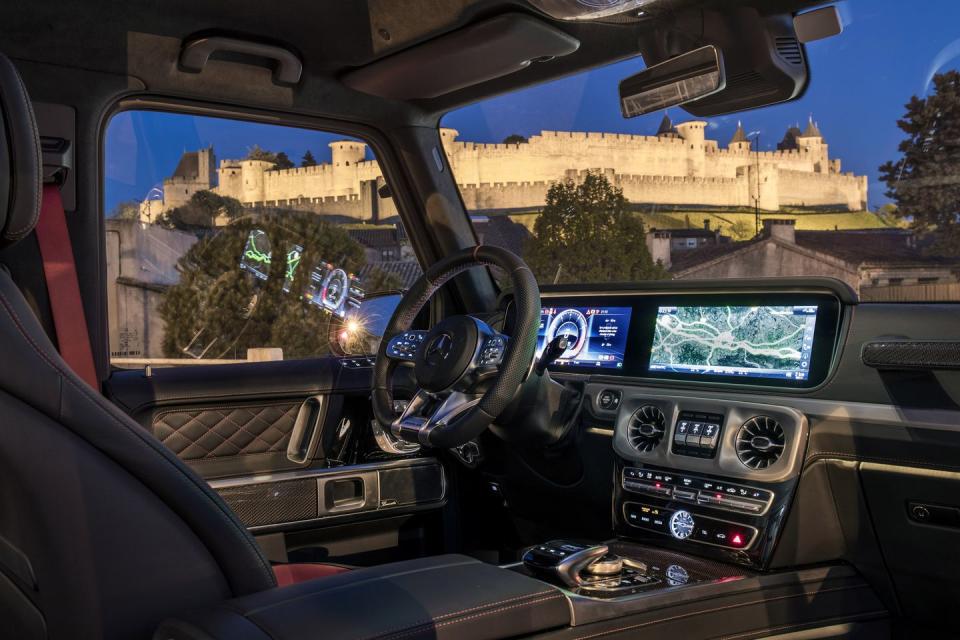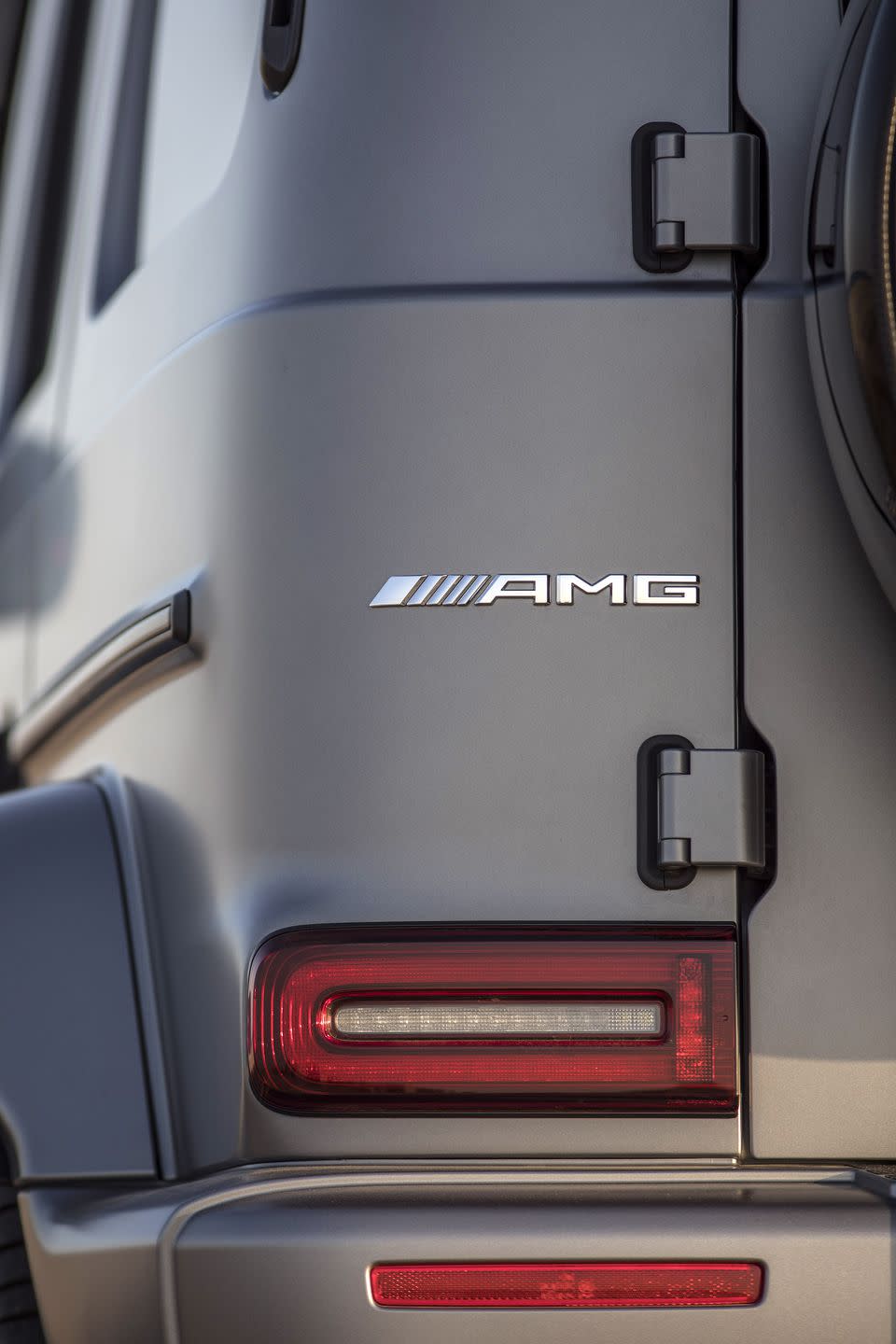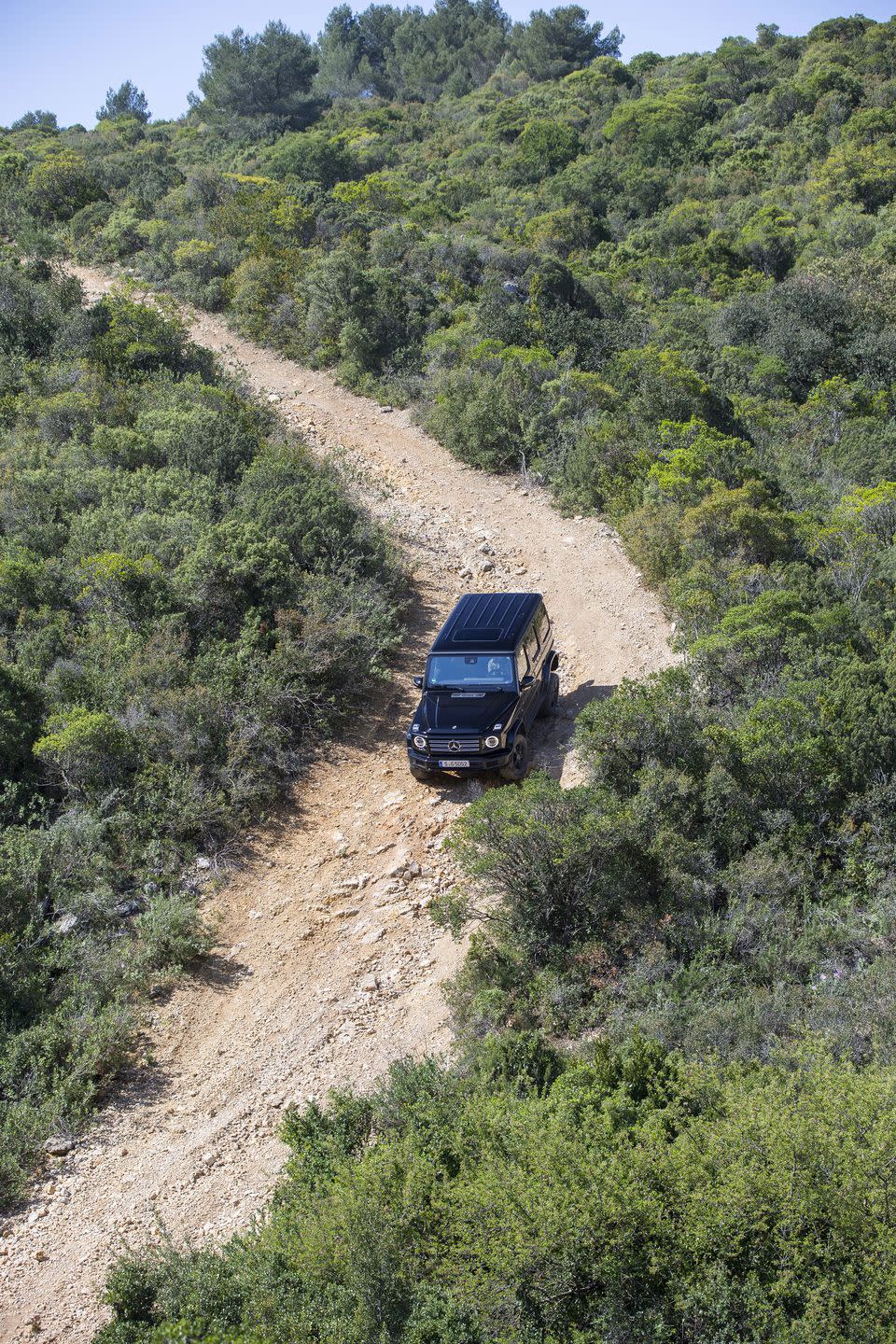2019 Mercedes-Benz G-Class: First Drive

Why do we love the Gelandewagen? On paper, it’s a mystery. The rig starts at more than $120,000, with some models commanding five times that. For all that money, you get a narrow, tippy-feeling 4x4 that’s ill at ease on any paved surface and pointedly unfriendly to drive. The chassis hasn’t been updated since 1990, and the bodywork has hardly budged in nearly four decades.
But people can’t stop buying them. Mercedes built more G-Class trucks in 2017 than any year since civilian sales began in 1979. In those 39 years, the rig has been remodeled like a house, new facades and interiors-and a freak parade of nuclear AMG engine options-hung from the original studs. Designed as a troop transporter and first sold as a pragmatic utility vehicle, the G has slowly morphed into an ultra-luxury fashion item, all without a major redesign. Mercedes began officially importing G-Wagens to the US in 2002; most of them seem to have ended up in the ritzy parts of New York and LA.
As SUVs begat CUVs and “sports activity vehicles,” the G-Class’s charm grew with age. The paramilitary looks and mud-buggy driving dynamics made the rest of the industry’s luxe-utes seem about as compelling as unbuttered toast. A German man took a 1980s G-Wagen on a 26-year tour of the globe, racking up more than a half million miles. Your Escalade is weak.
That’s why we loved the old G-Class. And now they’ve gone and changed the whole thing.

Mercedes didn’t necessarily want to do this. “Our idea was not to have a completely new vehicle, only a facelift,” Kurt Tomberger, Strategic Project Manager for the G-Class, told me at the automaker’s launch event in France.
But, well, have you ever tried to steer a Geländewagen? The old truck’s recirculating-ball setup was cribbed from a commercial truck, decades ago. It shows: You need both arms to wrench the thing into a curve and wrestle it straight again. Lane changes are a crapshoot. There’s no feel and hardly any assist. It’s a wonder G owners can keep it between the curbs.
So Mercedes set out to improve the rig’s on-road manners for 2019. A simple swap to rack-and-pinion steering was all it would take. Another benefit: The updated steering system would finally bring modern features like Park Assist to the G lineup.
One small problem: Rack-and-pinion doesn’t work on a solid front axle, the old-school suspension design that gave the G-Class its legendary off-road prowess. Designing an independent front suspension that wouldn’t impinge on that all-terrain ability required a new, stiffer frame. And what about all those crash tests that have come along in the 39 years since the G-Wagen was first introduced?
Tomberger chuckles. “In the end, I think it’s a little bit more than a facelift.”

The all-new 2019 G-Class shares only five components with the old model: Headlamp washers, outside door handles, sun visors, D-pillar vents, and the spare tire cover. It’s a few inches longer and wider than the old one, on a wheelbase stretched 1.6 inches and a track widened by a massive five inches. Thanks to studious engineering, it bears striking resemblance to the old truck. The exposed hinges and black plastic rain gutters remain, not for functional reasons, but because nixing them would have ruined the vibe. The front turn signals look exactly like the little lighthouses that sit atop every old G’s fenders, but they’re precisely designed for modern pedestrian crash safety standards-when struck by a sufficient load, they snap off their mounts and drop into the fenders. Designers minimized protrusions and shrank body gaps to eliminate wind noise, but staying faithful to the legendary silhouette meant keeping the drag: The new truck’s Cd, 0.55, is identical to the old model, the aero improvements counteracted by the added width.
All familiarity was abandoned in the interior. Where the old G was a grab-bag of components from Mercedes parts bins past, the new 4x4 offers the automaker’s latest dual-screen instrument panel and its most advanced infotainment system. About half of the new truck's added width goes in between the seats-driver and passenger no longer rub shoulders over big bumps, and there’s finally a real console bin, genuine cupholders, and a human-sized middle rear seat. The rest of the widening goes into side impact protection that had never been fathomed when the last G’s body was penned. That means the pencil-thin A-pillars of the old model are gone, and you can’t hang your arm over a plywood-narrow windowsill like you used to, but designers did an admirable job maintaining the low dash and expansive outward view of the original G.

The driving experience is decidedly un-nostalgic. The G-Class finally moves down the highway like a modern vehicle. It’s infinitely more planted. The new independent front suspension eliminates all the quiver and jostle of the old solid axle, replaced by a calm, compliant ride that compares favorably to the likes of Range Rover for the very first time. Gone is the tippy-toes, top-heavy feel of the old rig. The added track width makes this a completely different machine.
Some G hallmarks have stayed put. You still sit wooden-chair upright, left foot flat on the floor as you reach toward a steering wheel emanating from a shallow, near-vertical dashboard. Driving along, you feel like you’re sitting yards above passing traffic. The front turn signals double as rifle-sights as you try not to graze parked cars or encroaching walls. Despite weighing some 375 lbs. less than the old model, the new G is still a hefty machine, not built for hustling switchbacks or lasering apexes. Body roll is improved immensely but still present, and the slab-sided brute is still highly susceptible to crosswinds. But for the first time ever this rig feels at ease hammering down a freeway at 80mph. Or taking a curve at anything faster than a trot.



Two engines are available in the G-Class. Or rather, one engine-Mercedes’ venerable 4.0-liter hot-vee twin-turbo V8-in two flavors. The base-model G550 offers the same 416 horsepower and 450 lb-ft of torque as its predecessor, enough to hustle the rig from 0-60 in the low-five-second range. Step up to the high-performance Mercedes-AMG G63, and you’ll get 577 horses and 627 lb-ft of torque, along with a Mercedes-estimated 4.4-second 0-60 run. That’s nearly a full second quicker than the previous G63, a truck that drove like a riot in a knife factory.
A word on AMG G-Wagens: Mercedes’ hot rod office has been building them since the turn of our century. The appeal has always been the bonkers juxtaposition: Raunchy horsepower in a chassis designed for skillful off-road trundling. The old 563-horse G63 was a giddy handful. You were never quite sure if the slow, heavy steering could keep up with the rocket acceleration. Nailing the throttle on anything other than straight, level road felt like riding a roller coaster mid-implosion. If it wasn’t for full-time four-wheel drive, the world’s AMG G-Wagens would have depleted humanity’s reserves of tires by now.
The new G63 keeps the straight-line crazy and sponges away nearly all of the mid-corner panic. In the previous G63, it felt like the engine builders never asked the chassis engineers how much power the thing could handle. (Given that it’s been nearly 30 years since the last major G-Class chassis update, that’s probably true.) The 2019 model makes driving a rolling stone house with a snout full of torque seem nearly logical. It’s not just less panicky at high speeds, it’s almost happier there. The new G63 feels faster accelerating from 50 mph than from a stop, whipping off forceful upshifts toward an electronically-limited 149-mph top speed that somehow seems less gregariously suicidal than the old truck’s 130-mph max.
(Despite my asking multiple people in an increasingly plaintive tone, Mercedes currently has no plans to bring back the V12, 621-horse AMG G65.)

You might worry that, with all this improvement in on-road performance, the G’s legendary all-terrain prowess would suffer. Nothing could be less the case.
As with the old G, the new rig’s rough-country aplomb centers around three electric locking differentials. You lock them progressively as the terrain becomes more challenging, the trio of brushed-metal switches sitting in their traditional place of honor in the middle of the dash. First the rear (a solid axle located by a five-link suspension, the only stick axle left in the Mercedes SUV lineup), then the front, then, in really gnarly terrain, the center differential. There’s still a dedicated Low Range-engaged while coasting at low speed with the transmission in neutral, the old-fashioned way-bolstered by a new “G Mode” in non-AMG models that alters the engine, transmission and stability/traction programming for enhanced off-road ability.

The G’s rough-terrain capabilities may be digitally controlled now, but they’re based on old-school principles. There’s no brake-based hill-descent control-Low Range and first gear give you enough engine braking to inch down a puckeringly steep incline at a steady, calm crawl, no need to tap the brake pedal. Mercedes claims the truck can claw its way up or down an incline of up to 45 degrees. Plow through a deep water crossing, and a sensor hidden behind the front bumper activates the high-water engine air intake system. Mercedes recommends a maximum fording depth of 27.6 inches. Anecdotally, I can tell you that I had water crawling up the hood toward the base of the windshield with no ill effects.
Theoretically, the new independent front suspension should bring some limitations off-road. On uneven terrain, a solid axle articulates-as one wheel on an axle is pushed up into the wheelwell, the other is driven down, maintaining traction in a way independent setups can’t mimic. During hours of off-roading, the new G occasionally tipped a wheel skyward, but that never slowed the big brute’s progress. With a 31-degree approach angle, 30-degree departure, and 25.7-degree breakover, the G makes the most of its more than nine inches of ground clearance. An available adaptive-damper setup (optional on G550, standard on AMG G63) tunes itself on-the-fly, softening for major low-speed suspension flex and firming up for faster maneuvers.
An active-damper G550 is what Mercedes used to benchmark the new G-Class against the old on the Schockl Pass, a 3.5-mile off-road route near the Magna-Steyr factory in Graz, Austria, where every G has been hand-assembled. “They time it, it’s like our Nurburgring lap time,” Michael Rapp, Senior Manager at AMG, told me. After nearly 200 runs at Schockl, Mercedes development drivers were able to do the downhill in seven minutes and 25 seconds, an improvement of more than 30 seconds over the old rig. (The AMG G63, equipped with larger wheels, lower-profile tires, and a rear sway bar, is slightly more street-oriented than the G550, though it still impresses mightily off-road.)

The new G-Class is better than the old one in every way-on-road comfort, off-road prowess, interior appointments, acceleration, handling, you name it. So why does it leave me feeling so lukewarm?
The old G was unabashedly itself. You could feel its military roots with every mile. It was the vehicle we enthusiasts always swore we'd buy if automakers just had the guts to make them: A classic body with a modern-ish drivetrain. It spoke to you, albeit mostly in protest.
But in the four decades since the G was first designed, even the demands of the armed forces have changed. “The military people always tell us they need a very simple vehicle with no electronics,” Tomberger told me. “But they have helicopters, they have planes, all full of electronics. A modern tank is full of electronics”
The original Gelandewagen lived far beyond its life expectancy. The Mercedes M-Class, introduced in 1998, was meant to replace it. They’ve lived side-by-side on dealer floors for 20 years. In that time, the M underwent three facelifts, two complete redesigns, and a name change (it’s now the GLE-Class). The G was hardly touched.

That gave us 39 years to fall in love with the old G. To understand, accept, and eventually admire its flaws. To realize that the anodyne, unchallenging luxury SUVs of the world left us wanting something raw and engaging. Losing the old Gelandewagen feels like watching your childhood home get torn down. It’s being replaced by something roomier, more sensibly laid out, benefitting from modern construction but designed with classical style. It’s a smart decision, but smart is a long way from comforting.
Mercedes didn’t really have a choice in the matter. Crash testing and pedestrian safety laws are advancing worldwide, and they’re not friendly to 1970s designs. An AMG employee admitted to me, with slight exasperation, that fewer than 10 percent of G-Wagen owners take their rigs off-road.
Think of the impossibility of this task. Take Mercedes’ most iconic off-roader and turn it into a comfortable daily driver, while increasing the off-road capability that everyone demands but nearly nobody exercises. Fill it with the cutting-edge engineering knowledge of one of the world’s greatest automakers, but hide it all in a body that won’t jostle the sensibilities of a fan base that just wants everything to look like it did in 1979. Make it inviting to newcomers, but not off-putting to the old guard.
It’s a wonder Mercedes pulled it off. The new G-Class is an amazing machine, accomplishing every task in a way the old G never could. Finally, the Gelandewagen is a thoroughly modern vehicle.
But you can tell folks at Mercedes still harbor some nostalgia for the old rig. They may have leveled the house, but they kept the address: The internal chassis code for the new G-Class is 463, the same as it was for the last one.

You Might Also Like

 Yahoo Autos
Yahoo Autos 